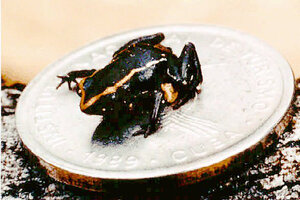World's smallest frog is also poisonous, research finds
Native to Cuba, the tiny Mount Iberia frog packs a poison punch, thanks to its diet of alkaloid-laden mites.

A frog discovered in Cuba currently holds the world record for the smallest frog. It's also poisonous.
Newscom/File
The record-holder for the smallest frog in the world apparently makes up for its miniature size by packing a wallop of poison, research reveals.
With a body that's only 10 millimeters long, the Mount Iberia frog (Eleutherodactylus iberia) from Cuba currently holds the Guinness World Record for smallest frog.
Investigating these dwarf frogs is painstaking work, said researcher Miguel Vences, an evolutionary biologist at the Technical University of Braunschweig in Germany.
"You have to crawl on your knees and move leaf by leaf," Vences told LiveScience. "And when you discover one of these frogs, they usually jump away immediately so that you have to start all over again."
When Vences found his first specimen, he smelled a bitter odor and suspected it might be coated in toxic alkaloids. (Morphine and caffeine are alkaloids.)
"At the time I just mentioned this as a crazy and rampant speculation — I was sure it would prove to be wrong, and was even more surprised when my chemistry colleagues sent me the first results, stating they indeed had found alkaloids in the skins," Vences said.
Only four other groups of frogs in the world secrete defensive toxins onto their skin, including the infamous poison-dart frogs of Latin America. It remains uncertain precisely how deadly this new poison dwarf might be.
The researchers suspect these dwarfs evolved their tiny size to better prey on mites overlooked as meals by larger frogs. These arachnids possess alkaloids the dwarfs secrete on their skins. And so by consuming the poison, the frogs somehow reallocated the goods for their own use. It was only later the frogs might have evolved their brown, yellow-striped appearance — "such a contrasting coloration usually is found in poisonous animals, which use it to deter potential predators," explained researcher Ariel Rodriguez of the Institute of Systematic Ecology at Havana.
A variety of tiny frogs roughly 10 millimeters long can be found around the world. These poisonous new findings could shed light on why this dwarf became so tiny.
"A more important question is probably why did the frogs not get even smaller?" Vences said. "In birds and mammals, who have to maintain a stable body temperature, you can understand why they cannot get smaller than a dwarf shrew or a tiny hummingbird — as the body surface relative to body volume increases as you get smaller, you are cooling more easily, so you need more energy to maintain your temperature. This only works to a certain size well above the 10 millimeters found in frogs."
However, frogs, being cold-blooded, do not need to maintain a stable body temperature.
"So what is the limiting factor? Is it ecological, that there is not enough prey available for frogs under 8 to 10 millimeters?" Vences speculated. "Is it developmental, some fundamental processes in the body, like producing eggs, not being possible in smaller frogs? Physiological, related to water loss? In these questions, I see the greatest challenge, and this is where studies of miniaturization of vertebrates will be able to provide data of more fundamental importance, far beyond the pure curiosity of just their dwarf size."
The scientists detailed their findings online Nov. 3 in the journal Biology Letters.
